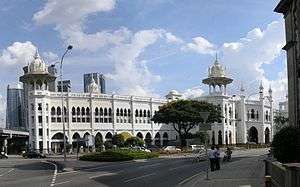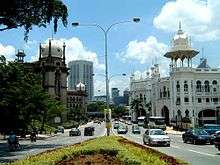Kuala Lumpur railway station
KA02 Kuala Lumpur 吉隆坡火车站 | ||||||||||||||||||||||||||||||||||||
|---|---|---|---|---|---|---|---|---|---|---|---|---|---|---|---|---|---|---|---|---|---|---|---|---|---|---|---|---|---|---|---|---|---|---|---|---|
|
KTM Komuter Commuter Rail Station KTM Intercity Station | ||||||||||||||||||||||||||||||||||||
 A view of Kuala Lumpur railway station, as seen towards the southeast. | ||||||||||||||||||||||||||||||||||||
| Location | Jalan Sultan Hishamuddin, Kuala Lumpur, Malaysia. | |||||||||||||||||||||||||||||||||||
| Coordinates | 3°8′22″N 101°41′36″E / 3.13944°N 101.69333°E | |||||||||||||||||||||||||||||||||||
| Owned by | Keretapi Tanah Melayu | |||||||||||||||||||||||||||||||||||
| Line(s) |
Seremban Line and Port Klang Line (KTM Komuter) (1995 to present) North-South Line and KL Sentral-Ipoh Route (KTM Intercity) ETS Line | |||||||||||||||||||||||||||||||||||
| Platforms | 2 side platforms and 1 island platform | |||||||||||||||||||||||||||||||||||
| Tracks | 4 | |||||||||||||||||||||||||||||||||||
| Construction | ||||||||||||||||||||||||||||||||||||
| Parking | Available | |||||||||||||||||||||||||||||||||||
| Other information | ||||||||||||||||||||||||||||||||||||
| Station code | KA02 | |||||||||||||||||||||||||||||||||||
| History | ||||||||||||||||||||||||||||||||||||
| Opened | 1886 | |||||||||||||||||||||||||||||||||||
| Rebuilt | 1910 | |||||||||||||||||||||||||||||||||||
| Electrified | 1995 | |||||||||||||||||||||||||||||||||||
| Services | ||||||||||||||||||||||||||||||||||||
| ||||||||||||||||||||||||||||||||||||
Kuala Lumpur railway station (Malay: Stesen keretapi Kuala Lumpur; Jawi: ستيسين كريتاڤي كوالا لومڤور; Chinese: 吉隆坡火车总站) is a railway station located in Kuala Lumpur, Malaysia. Completed in 1910[1] to replace an older station on the same site, the station was Kuala Lumpur's railway hub in the city for the Federated Malay States Railways and its successor Keretapi Tanah Melayu (English: Malayan Railways), before Kuala Lumpur Sentral assumed much of its role in 2001. The station is notable for its architecture, adopting a mixture of Eastern and Western designs.
The station is located along a road named Jalan Sultan Hishamuddin, previously known as Victory Avenue, which in turn was part of Damansara Road. The station is located closely to the similarly designed Railway Administration Building, as well as the National Mosque and Dayabumi Complex. The Pasar Seni LRT station is located 400 metres away, across the Klang River.
History
Preceding stations
Prior to the construction of the current Kuala Lumpur station, two stations were already operational in the city.
The first Kuala Lumpur Railway Station, nicknamed Resident Station due to its proximity to the residence of the British Resident, was completed and located opposite to the Selangor Club towards the west. Constructed of wood and a nipah palm roof, the station was the first in Kuala Lumpur, linking Kuala Lumpur to Klang (Pengkalan Batu) via the first railway line to connect the city with the rest of the Malay Peninsula (officially inaugurated 22 September 1886).
The second station, Sultan Street Station, was constructed in 1892 at Foch Avenue (now Tun Tan Cheng Lock Road), close to the present Maybank Tower, the Puduraya bus station and SP8 Plaza Rakyat. Its design was based on Resident Station, and was stationed along the Pudu railway line, a new line that branched off north from the 1910 station, and connected mines from Ampang to the city. The line was unique in that the initial leg of the track approaching Sultan Street Station from the main line was sandwiched between two carriageways of Foch Avenue, cutting across the east side of the city.
Resident Station was demolished after construction of the new Kuala Lumpur station was completed. Meanwhile, Sultan Street Station was replaced by a smaller terminal station when the tracks at Foch Avenue were dismantled for road traffic, and was demolished after 1960. The Ampang-linked route is partially reused by the Ampang rapid transit line.
Design, construction and operation
_(frontal_facade)%2C_Kuala_Lumpur.jpg)

Arthur Benison Hubback, a British Architectural Assistant to the Director of Public Works, undertook the design of the station. He incorporated the unique Anglo-Asian architecture in the region on the station's design. The "Neo-Moorish/Mughal/Indo-Saracenic/Neo-Saracenic" style was not uncommon at the time. Similar structures, such as the Sultan Abdul Samad Building (designed by A.C. Norman, completed 1897), the Old City Hall (designed by A.B. Hubback, completed 1904) and the Jamek Mosque (designed by A.B. Hubback, completed 1909), pre-date Kuala Lumpur station.
At a cost of $23,000, the station was completed and operational on 1 August 1910. After the demolition of Resident Station and the isolation of Sultan Street Station, Kuala Lumpur Railway Station became the main railway station in Kuala Lumpur. A hotel, the Station Hotel, occupied part of the station, being renamed the Heritage Station Hotel in 1996 and it remained functioning until 2010.[2] In 1995, access to KTM Komuter services was introduced at the station.
After the diversion of long-distance intercity rail traffic on 15 April 2001 to Kuala Lumpur Sentral, less than a kilometer south, the original station's importance diminished and redundant station facilities were withdrawn. Intercity trains still pass through this station but no longer stop here. While the side platforms of the station were raised to a height suitable for smooth embarking and disembarking from KTM Komuter trains, the current configuration of the platforms and access to services meant that the original station could not be maximised for use as a transportation stop for KTM Komuter passengers (see platform). The entire station is still served by both KTM Komuter and goods services.
In months leading up to 31 August 2007, the 50th anniversary of Malaya's independence, various sources reported the transfer of various old railway equipment from a railway warehouse in Klang and a few other locations to the old Kuala Lumpur station. This included a small restored shunter and an antique fire engine. The station was officially reopened on 31 August 2007 as a railway museum (where exhibitions are placed in the main hall and platform of the station), and is currently mooted as a cultural centre.
Renovations, upgrades and changes

The station has undergone several major changes in its more recent history. The north wing was converted for office use by 1967, closing off the arched verandahs with windows. In 1986, the station was more extensively refurbished, with the interior and relevant windows replaced with modern counterparts while the exterior was repaired and preserved, and additional new facilities and buildings, including air-conditioned waiting halls, tourism information counters and snack bars. Parts of the station's original interior designs and frames are still present in the Heritage Station Hotel.
The refurbishment also saw an additional extension built on the south wing of the building, sporting "Raj" stylings that dominates much of the building, and the addition of a frontal façade for the north wing that sports similar architectural elements, masking hints of Western designs from the front. These changes resulted in the building sporting two additional chhatris, two on the corner of each wing, alongside the original four.
Other modifications made onto the old building included the rear wall of the station carved open and extended to accommodate a new station entrance, taxi stops, several office and retail spaces, while additional double-storey retail spaces were constructed over one of the two adjacent frontal access roads to the main building.
The 1986 remodelling also saw platform extensions to the north and a new station building in the area, which connected to the General Post Office at the then newly completed Dayabumi complex (constructed 1982 to 1984).
When KTM Komuter services were launched in 1995 to serve the Rawang-Seremban Route and the Sentul-Port Klang Route, ticket counters and faregates were added to the station, in common with other KTM Komuter stations. The location of Komuter facilities meant that only the newer island platform could be used by KTM Komuter trains (see platform).
After Kuala Lumpur Sentral assumed the responsibility of receiving intercity operations, portions of station facilities designated for intercity services were decommissioned or removed.
Platforms
_(original_terminal)%2C_Kuala_Lumpur.jpg)
The station contains three raised platforms serving four railway lines, consisting two side platforms (platforms 1 and 4) on both sides and one island platform (platforms 2 and 3) in between. Extension platforms added in 1986 are assigned additional "a" suffixes, i.e. Platform 2a for the extension of the original platform 2.
Prior to the opening of Kuala Lumpur Sentral, the platforms were designated the following roles:
- The station's side platforms are typically assigned to service Intercity train services. As such, ticket counters for the train services were located within the old and new stations. With Intercity services shifted to Kuala Lumpur Sentral in 2001, passenger traffic at the platform has virtually disappeared. The platforms are still used to transfer goods to and from trains. The side platforms, like the ground level of the station building, are open to the public. However, in 2011, the side platforms are reused to cater Intercity services with tickets sold at the ETS ticket counter.
- The station's island platform is typically assigned to cater KTM Komuter services from both the Rawang-Seremban and Sentul-Port Klang Routes as well as the Electric Train Service, as KTM Komuter ticket counters and faregates to and from KTM Komuter services are connected to it, the ETS ticket counters, however are located in their former railway fan clubhouse.
In addition, the old island platform remains at its original height as it was when the station was built, significantly lower than the island platform extension and doorways of the commuter trains, an inconvinience to passengers entering and exiting Komuter trains. Accordingly, KTM Komuter trains typically stop at the new platforms, prompting passengers to leave the station via the newer, northern exit. However, as of 18 December 2009, after renovations to the old sections of platform 2 and 3, the Komuter trains now stop within the original section of the station with the platform heights being raised to meet the floor level of the trains.
Architecture
Kuala Lumpur Railway Station initially consisted of a main terminal building at the front and three platforms serving four railway lines at the back.
The main structure, which contains a main hall, ticket counters and offices, is primarily designed in a "Raj" styling, mixture of Western and Mughal similar to Moorish Revival or Indo-Saracenic architecture, which enjoyed brief popularity in late-19th century and early 20th century colonial India, as well as Europe and the. Dominated by horseshoe and ogee arches, and large chhatris (six originally, with two added later) at the corners of the building accompanying smaller variations at the front, the station is comparable to the Sultan Abdul Samad Building and surrounding structures constructed around the Merdeka Square during the period. In addition to the main station building, a three-storey addition at the north wing was added early in its operation, adopting Westernised vernacular designs with surrounding venrendahs and segmental arches of various widths. The façade of the station is completely plastered, as opposed to buildings of similar styles that opt for exposed brickwork, and painted in light colours (usually white or cream) throughout its service.
The platforms are covered by large steel-framed shelters, which were initially shorter during the station's early operation. The roofs were originally glazed, and were partially opened to allow smoke from steam locomotives to escape; corrugated roof sheets served as replacements later in the station's life. The sides of the platforms not adjoining the main building are surrounded by walls constructed in the same style as the main building. The platforms and main building are linked to each other via two underground passageways.
The design of the extended platform for the 1986 refurbishment of the station took a more modernist approach, consisting simply of large concrete pillars supporting a latticed roof and a ticket office on concrete slabs at the north end, suspended two stories above ground. White walls and arches that serve as decorations to the extension are more alike that of the Dayabumi complex than the original station. The new extension is connected to Dayabumi via an elevated walkway.
Around the station
See also
References
- ↑ "Kuala Lumpur Railway Station". keretapi.com. Retrieved 25 August 2012.
- ↑ “A loss to K.L” . . https://www.tripadvisor.com.au/ShowUserReviews-g298570-d637810-r263673793-Heritage_Station_Hotel-Kuala_Lumpur_Wilayah_Persekutuan.html
External links
| Wikimedia Commons has media related to Kuala Lumpur Railway Station. |